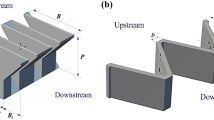Abstract
Piano Key Weirs (PKW) is a free-flowing weir, and an improvement over the labyrinth weir family. PKW has higher discharge for the same head as compared to other types of weirs. They tend to reduce the upstream submergence in reservoirs or other flow systems and can be effectively used for flood risk mitigation. CFD studies have been carried out earlier but mostly for H/P (Total head to height ratio) greater than 0.1. The present paper investigates the use and validation of Computational Fluid Dynamics (CFD) for modeling Open Channel flows over common hydraulic structures such as PKW for small discharges with the entire range of head to height ratio h/P from 0.035 to 0.1, where h is not the total head upstream of PKW but the head measured at the crest of PKW. The numerical results have been validated with experimental results. Since the discharge is minimal surface tension force has been incorporated in the numerical model. The numerical model is a half PKW unit model with the same geometrical parameters as the experimental setup from Literature. The results show that CFD simulations can reproduce flow depths near PKW with reasonably good accuracy. The present paper compares the head obtained from CFD with that of empirical formula in the Literature but with head measured at the crest of PKW. Investigation of water surface profile and velocity profile near the upstream of PKW has also been carried out.






Similar content being viewed by others
REFERENCES
Abrari, L., Talebbeydokhti, N., and Sahraei, S., Investigation of hydraulic performance of piano shaped weirs using three dimensional numerical modeling, Iran. J. Sci. Technol., 2015, vol. 39(C2+), pp. 539–558. https://doi.org/10.22099/IJSTC.2015.3519
Anderson, R. and Tullis, B., Piano key weir: Reservoir versus channel application, ASCE J. Irrig. Drain. Div., 2012, vol. 138, no. 8, pp. 773–776.
Anderson, R.M., Piano Key Weir Head Discharge Relationships, Utah State University, 2011.
Bashiri, H., et al., Towards a new design equation for piano key weirs discharge capacity, Int. sympos. Hydraulic Structures, Utah State Univ., 2016. https://doi.org/10.15142/T3310628160853
Bieri, M., et al. Réhabilitation de la capacité d’évacuation des crues–Intégration de PK-Weirs sur des barrages existants, Proc., Colloque CFBR-SHF, Dimensionnement et fonctionnement des évacuateurs de crues, Société Hydrotechnique de France (SHF) Paris, 2009.
Carrillo, J.M., Matos, J., and Lopes, R., Numerical modeling of free and submerged labyrinth weir flow for a large sidewall angle, Environ. Fluid Mech., 2019, pp. 1–18.
Eng, B.M. and Lennart, F., Numerical uncertainty of Piano Key Weir discharge coefficient estimations by means of 3D CFD modelling-a preliminary study, Int. sympos. Hydraulic Structures, Utah State Univ., 2018.
Erpicum, S., et al., Numerical and physical hydraulic modelling of Piano Key Weirs, Proc. 4th Int. Conf. on Water Resources and Renewable Energy Development in Asia, 2012.
Fleit, G., Baranya, S., and Bihs, H., CFD modeling of varied flow conditions over an ogee-weir, Periodica Polytechnica-Civil Engineering, 2017.
Haun, S., Olsen, N.R.B., and Feurich, R., Numerical modeling of flow over trapezoidal broad-crested weir, Engineering Applications of Computational Fluid Mechanics, 2011, vol. 5, no. 3, pp. 397–405. https://doi.org/10.1080/19942060.2011.11015381
Hu, H., et al., Numerical study of characteristics and discharge capacity of piano key weirs, Flow Measurement and Instrumentation, 2018, vol. 62, pp. 27–32. https://doi.org/10.1016/j.flowmeasinst.2018.05.004
Kabiri-Samani, A. and Javaheri, A., Discharge coefficients for free and submerged flow over Piano Key weirs, J. Hydraulic Res., 2012, vol. 50, no. 1, pp. 114–120. https://doi.org/10.1080/00221686.2011.647888
Laugier, F., Design and construction of the first Piano Key Weir spillway at Goulours dam, Int. J. Hydrop. Dams, 2007, vol. 14, no. 5, pp. 94.
Leite Ribeiro, M., et al., Discharge capacity of piano key weirs, J. Hydraul. Eng., 2011, vol. 138, no. 2, pp. 199–203. https://doi.org/10.1061/(ASCE)HY.1943-7900.0000490
Lempérière, F. and Ouamane, A., The Piano Keys weir: a new cost-effective solution for spillways, Int. J. Hydrop. Dams, 2003, vol. 10, no. 5, pp. 144–149.
Lempérière, F. and Vigny, J., General comments on labyrinth and Piano Keys Weirs–The future, Labyrinth and piano key weirs–PKW 2011, 2011, pp. 289–294.
Machiels, O., et al. Large scale experimental study of piano key weirs, Proc. 33rd IAHR Congress: Water Engineering for a Sustainable Environ., IAHR, 2009.
Muslu, Y., Numerical analysis for lateral weir flow, J. Irrig. Drainage Eng., 2001, vol. 127, no. 4, pp. 246–253. https://doi.org/10.1061/(ASCE)0733-9437(2001)127:4(246)
Oertel, M., Discharge Coefficients of Piano Key Weirs from Experimental and Numerical Models, E-proc. 36th IAHR World Congress, 2015.
Ouamane, A., Nine years of study of the Piano Key Weir in the university laboratory of Biskra “lessons and reflections,” Proc. Int. Conf. Labyrinth Piano Key Weirs-PKW 2011, London: Taylor & Francis, 2011.
Ouamane, A. and Lempérière, F., Design of a new economic shape of weir, Proc. Int. Sympos. Dams in the Societies of the 21st Century, 2006.
Pralong, J., et al., A naming convention for the piano key weirs geometrical parameters, Labyrinth and Piano Key Weirs, 2011, pp. 271–278.
Qu, J., et al., Numerical simulation of sharp-crested weir flows, Can. J. Civ. Eng., 2009, vol. 36, no. 9, pp. 1530–1534. https://doi.org/10.1139/L09-067
Ribeiro, M., et al., Rehabilitation of St-Marc dam. Experimental optimization of a piano key weir, Proc. of the 32nd Congress of IAHR, 2007.
Ribeiro, M.L., et al., Hydraulic design of A-type piano key weirs, J. Hydraulic Res., 2012, vol. 50, no. 4, pp. 400–408. https://doi.org/10.1080/00221686.2012.695041
Sharma, N. and Tiwari, H., Experimental study on vertical velocity and submergence depth near Piano Key Weir, Labyrinth and Piano Key Weirs II-PKW, 2013, pp. 93–100.
Tiwari, H. and Sharma, N., Empirical and Mathematical Modeling of Head and Discharge over Piano Key Weir, Development of Water Resour. India, Springer, 2017, pp. 341–354.
ACKNOWLEDGMENTS
We acknowledge IIT (BHU), Varanasi for infrastructure support as well as Main Library IIT (BHU), Varanasi, for paper downloads.
Author information
Authors and Affiliations
Corresponding authors
Rights and permissions
About this article
Cite this article
Abhash, A., Pandey, K.K. Numerical Study of Discharge-Head Relationship of Piano Key Weirs for Low Heads. Water Resour 48, 235–244 (2021). https://doi.org/10.1134/S0097807821020020
Received:
Revised:
Accepted:
Published:
Issue Date:
DOI: https://doi.org/10.1134/S0097807821020020




